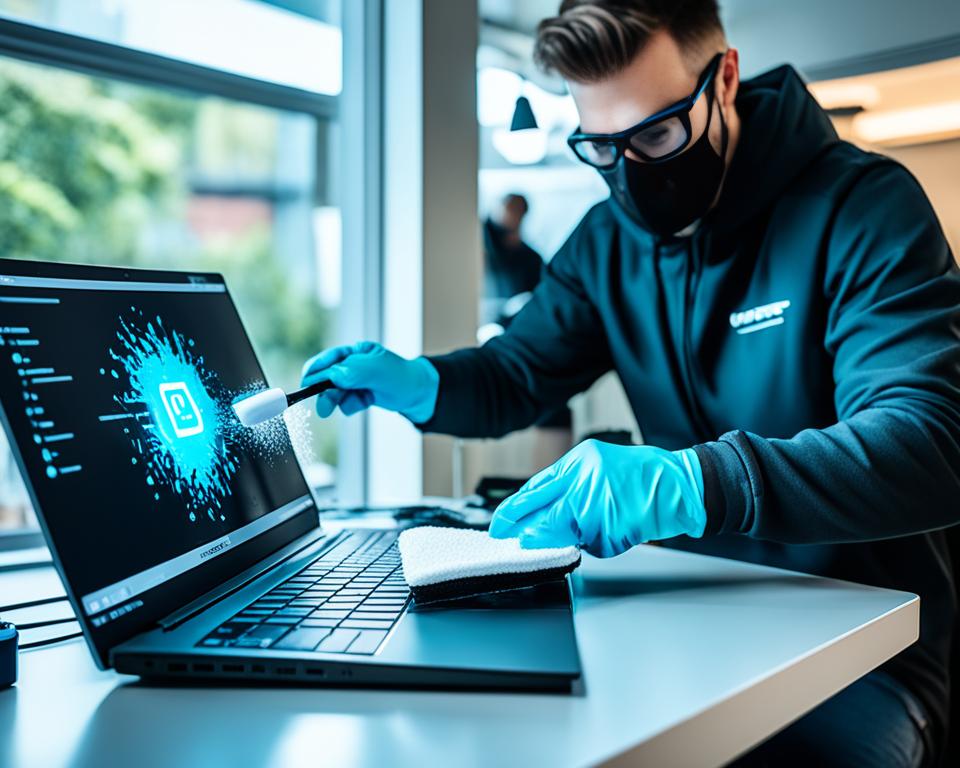Keeping your PC clean and dust-free is essential for optimal performance and longevity. While compressed air is commonly used to clean PCs, it may not always be readily available or preferred due to its cost and environmental impact. Fortunately, there are alternative methods that are just as effective in removing dust and debris from your PC without the need for compressed air. In this article, we will explore these alternative cleaning methods, providing you with step-by-step guidance on how to clean your PC without compressed air.
An Unfortunate Coffee Incident
Picture this: You’re sitting at your desk, engrossed in an important project on your PC. As you reach for your coffee mug, disaster strikes. The mug tips over, and before you can react, a stream of hot coffee cascades onto your keyboard and seeps into the crevices of your PC.
Panic sets in as you quickly power down your PC and assess the damage. You know you need to clean the spill before it causes irreparable harm. But what do you do without compressed air? How do you clean your PC effectively and safely?
Luckily, there are alternative cleaning methods that can help you tackle the task at hand. By using simple household items and following the right techniques, you can clean your PC without compressed air and restore it to its former glory.
Key Takeaways:
- Compressed air is not the only option for cleaning your PC.
- Alternative cleaning methods can be just as effective.
- Household items like brushes and lint-free cloths can be used.
- It is important to power down your PC and take precautions before cleaning.
- Regular cleaning will help maintain optimal performance and prevent damage.
Manually remove the dust
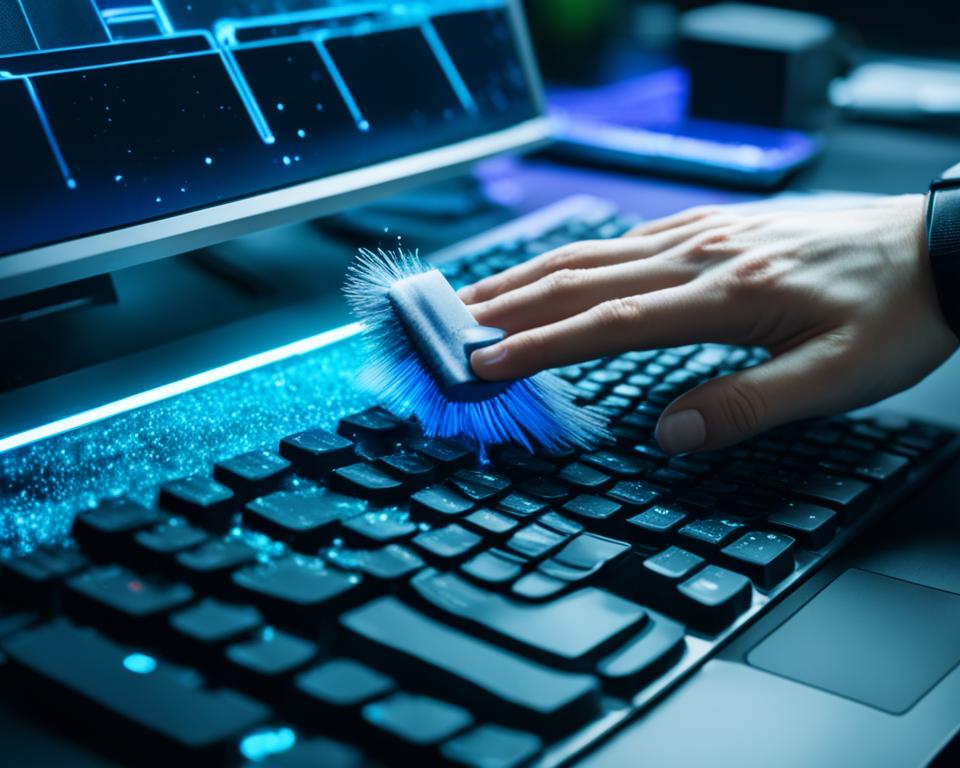
When it comes to cleaning your PC without compressed air, there are alternative methods you can employ. One simple yet effective technique is to manually remove the dust from your keyboard.
To get started, turn your keyboard upside down and gently shake it to dislodge any loose debris. You can do this over a trash can or use a dust rag to collect the debris.
This method is particularly useful for removing dust and crumbs that have accumulated between the keys. By shaking and tapping the keyboard, you can loosen and dislodge the debris, ensuring a cleaner and more responsive typing experience.
In addition to shaking, you can also use a soft brush or cloth to wipe away any stubborn dust particles. Ensure that the brush or cloth is clean and free from moisture to avoid damaging your keyboard.
By manually removing dust from your keyboard, you can maintain its performance and prevent any build-up that may affect its functionality over time.
Use dry brushes
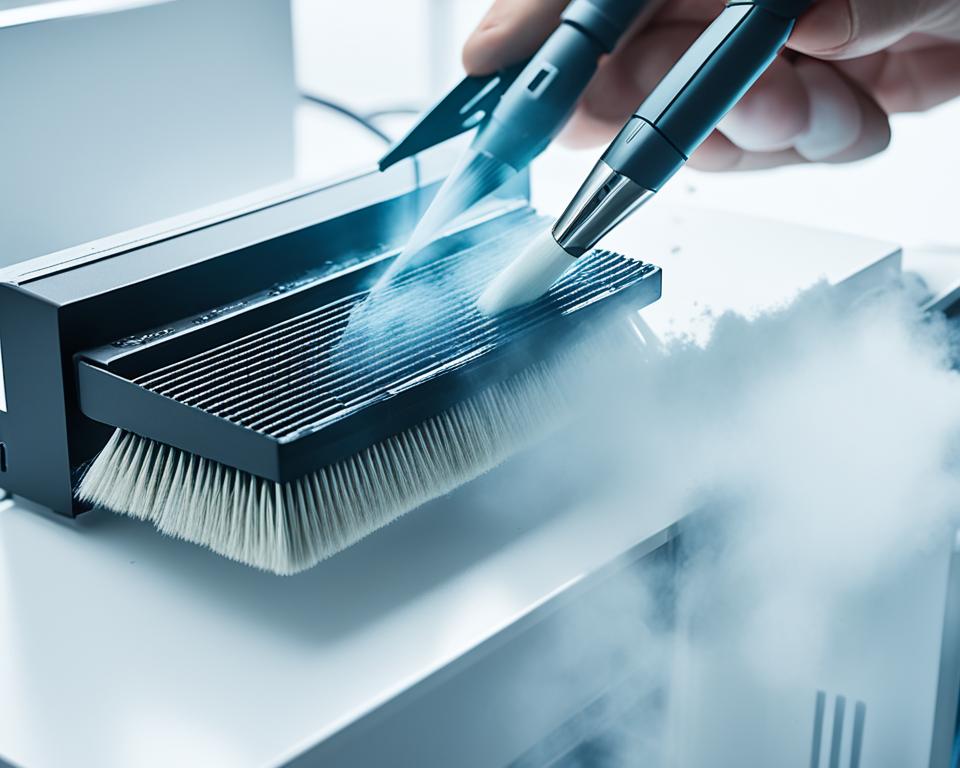
If you don’t have access to compressed air, there are alternative methods to clean your PC and remove dust effectively. One such method is using dry brushes, which can be readily available in your home.
Dry brushes such as makeup brushes, toothbrushes, or small paintbrushes can be utilized to clean your PC components without the need for compressed air. These brushes are particularly handy for reaching and removing dust from hard-to-reach places, like the crevices of your keyboard, the intricate details of your CPU cooler, or the fan blades inside your computer case.
This technique is highly effective in removing dust particles that may hinder your PC’s performance or cause overheating issues. The soft bristles of these brushes ensure that delicate components are not damaged during the cleaning process.
To clean your PC using dry brushes, follow these simple steps:
- Power down your PC and unplug it from its power source. This is crucial for your safety and to prevent any accidental damage to the components.
- Identify the areas of your PC that require cleaning. This could include the keyboard, the cooling fans, the heat sinks, or any other visible dust-prone parts.
- Gently brush the surface with the dry brush, using soft and controlled strokes. Make sure to remove any loose dust or debris that has accumulated.
- For tight corners and hard-to-reach areas, use smaller brushes like toothbrushes or paintbrushes to ensure a thorough cleaning.
- After cleaning, use a lint-free cloth or a microfiber cloth to wipe away any remaining dust or particles.
By using dry brushes, you can effectively maintain a clean and dust-free PC, ensuring optimal performance and prolonging the lifespan of your computer.
Wipe down with a lint-free cloth
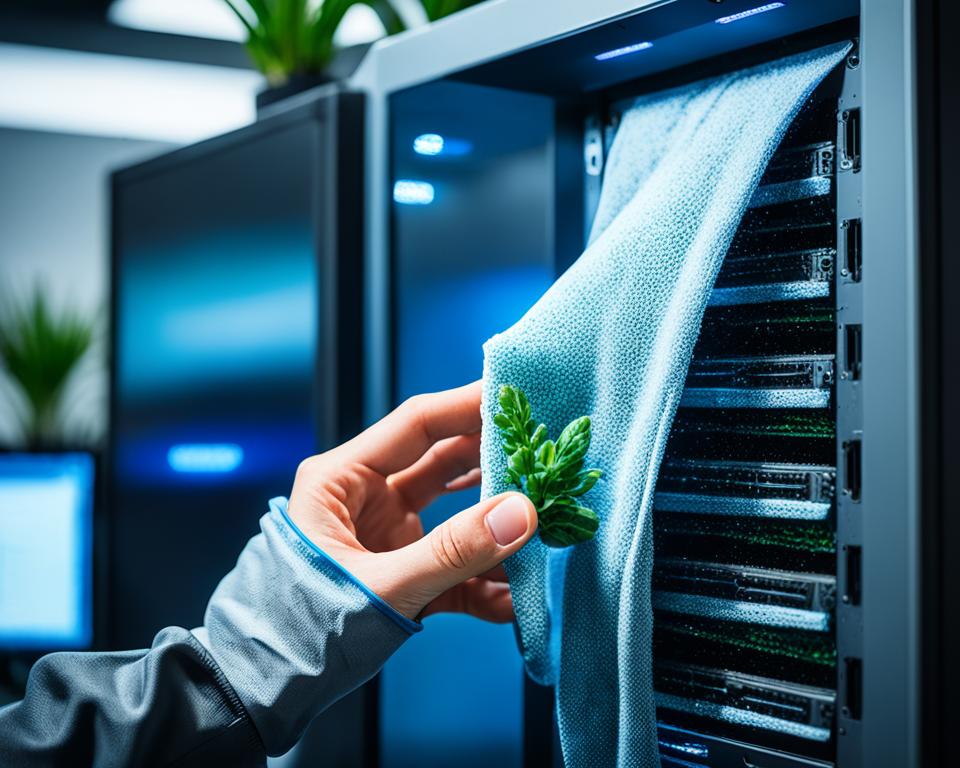
After removing internal dust, dirt, and debris, you can wipe down your PC with a lint-free cloth. This cloth provides an effective non-toxic method for removing surface dust and dirt from your PC without the need for compressed air. Simply gently wipe the cloth over the exterior of your PC, paying attention to areas like the keyboard, monitor, and case.
If you need to disinfect your keyboard, you can dampen the lint-free cloth with a small amount of isopropyl alcohol or peroxide. This will help to kill bacteria and remove any germs. Be sure to wring out the cloth so it is only slightly damp and not dripping wet. It is important to use a small amount of cleaning solution to avoid any potential damage to your computer.
Benefits of using a lint-free cloth:
- Non-toxic and environmentally friendly
- Removes surface dust and dirt effectively
- Can be used to disinfect your keyboard
- Doesn’t require compressed air or other chemicals
| Materials | Instructions |
|---|---|
| Lint-free cloth | 1. Power down your PC |
| Isopropyl alcohol or peroxide | 2. Dampen the lint-free cloth |
| 3. Gently wipe down the exterior of your PC | |
| 4. For keyboard disinfection, lightly dampen the cloth with isopropyl alcohol or peroxide | |
| 5. Wring out the cloth to remove excess moisture | |
| 6. Wipe the keyboard, paying attention to areas between the keys | |
| 7. Allow your PC to dry completely before turning it on |
Remember to always take precautions when cleaning your PC. Avoid using abrasive materials or excessive force that could damage the surface or components of your PC. If you are unsure about any specific cleaning methods, it’s best to consult the manufacturer’s guidelines or seek professional advice.
Use an electric air duster
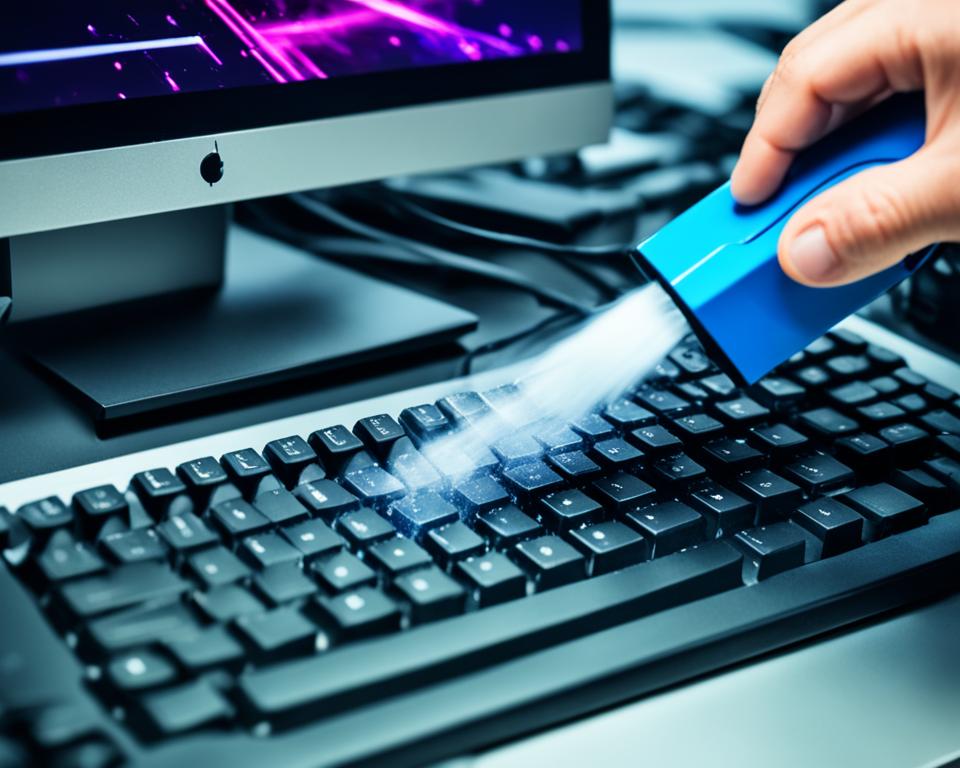
When it comes to cleaning your PC without compressed air, an electric air duster is a highly recommended alternative. This rechargeable device offers considerable advantages over traditional compressed air canisters, making it a valuable tool for PC maintenance.
One of the key benefits of an electric air duster is that it is more cost-effective in the long run. Unlike compressed air canisters that need to be constantly replaced, an electric air duster can be used repeatedly without the need for refills. This not only saves you money but also reduces waste, making it an environmentally friendly choice.
Furthermore, an electric air duster comes with attachments specifically designed to assist with cleaning keyboards. These attachments help to remove trapped crumbs and dirt from between the keys, ensuring a thorough clean. By using the electric air duster’s gentle blowing action, you can dislodge and remove debris that may impair your keyboard’s functionality.
It’s important to note that while an electric air duster is a highly effective tool, it should be used with caution. Avoid using excessive force or getting too close to sensitive components, as this can cause damage. Always follow the manufacturer’s instructions and take necessary precautions when using any cleaning tool on your PC.
In conclusion, utilizing an electric air duster is a reliable and efficient method for cleaning your PC without compressed air. Its cost-effectiveness, environmental friendliness, and specialized attachments make it an excellent alternative to traditional cleaning methods. By incorporating an electric air duster into your PC maintenance routine, you can ensure that your computer stays clean and performs optimally.
Avoid hair dryers
When it comes to cleaning your PC without compressed air, it is crucial to avoid using hair dryers or vacuums. These appliances may seem like a convenient option, but they can actually cause static, which can damage sensitive computer components. Instead, it is recommended to consider using a mini-keyboard vacuum as a safer alternative to compressed air.
A mini-keyboard vacuum is specifically designed for cleaning keyboards and other electronic devices. It is compact, lightweight, and portable, making it easy to maneuver around your PC without causing any harm. The vacuum’s gentle suction power effectively removes dust and debris from hard-to-reach areas, ensuring a thorough cleaning.
Before using the mini-keyboard vacuum, make sure to power down your PC and unplug it from the power source. This will help prevent any accidental damage while you clean. Start by gently running the vacuum over the surface of your keyboard, focusing on the spaces between the keys. Move the vacuum slowly to allow it to capture all the dust particles.
In addition to cleaning the keyboard, you can also use the mini-keyboard vacuum to remove dust from other areas of your PC, such as the vents and fan grills. The vacuum’s narrow attachment can easily fit into these spaces, helping to maintain optimal airflow and prevent overheating.
By avoiding hair dryers and opting for a mini-keyboard vacuum, you can clean your PC without the risk of static damage. This method ensures a safe and effective cleaning process, keeping your computer running smoothly and prolonging its lifespan.
Benefits of Using a Mini-Keyboard Vacuum:
- Gentle and safe cleaning
- Compact and portable
- Efficient dust removal
- Prevents static damage
- Helps maintain optimal airflow
What Do You Need?
To effectively clean your PC without compressed air, you will need the following tools and supplies:
| Tools and Supplies |
|---|
| Screwdriver |
| Old toothbrush or paintbrush |
| Isopropyl alcohol |
| Cotton pads and swabs |
| Piece of cloth |
These items are easily accessible and will assist you in safely and effectively cleaning the dust from your PC. Let’s take a closer look at each item:
Screwdriver
A screwdriver is essential for opening up your PC’s case to access its internal components. Make sure to use the appropriate screwdriver size depending on the type of screws used in your PC.
Old Toothbrush or Paintbrush
An old toothbrush or paintbrush can be used to remove dust and debris from hard-to-reach areas, such as between keyboard keys and fan blades. Make sure the brush is clean and dry before using it.
Isopropyl Alcohol
Isopropyl alcohol helps in cleaning and disinfecting surfaces. It can be used with a cotton pad or swab to wipe down your PC’s exterior and remove stubborn stains or dirt. Remember to apply the alcohol sparingly and avoid getting it on sensitive components.
Cotton Pads and Swabs
Cotton pads and swabs are useful for applying isopropyl alcohol or other cleaning solutions to smaller or delicate areas of your PC. They can help remove grime or buildup in crevices and corners.
Piece of Cloth
A soft, lint-free cloth is ideal for wiping down screens, keyboards, and other surfaces. It helps remove fingerprints, smudges, and light dust without scratching or damaging your PC.
With these tools and supplies, you’ll be equipped to clean your PC effectively and safely without relying on compressed air.
Note: Remember to power down your PC and unplug it from the power source before starting the cleaning process. Safety should always be your top priority.
Step-By-Step Guide
When it comes to cleaning your PC without compressed air, following a step-by-step guide will ensure a thorough and effective cleaning process. Before you begin, make sure to turn off your PC and disconnect it from any power source to avoid accidental damage.
Cleaning the Case
The first step is to clean the case of your PC. Use a soft, lint-free cloth or a microfiber cloth to wipe the exterior of the case. Gently remove any visible dust or dirt, paying attention to the vents and fan openings. For stubborn dirt, you can lightly dampen the cloth with a small amount of isopropyl alcohol.
Cleaning the Hardware
Next, it’s important to clean the hardware components of your PC, including the CPU, graphics card, power supply, and motherboard. Use a soft brush, such as a paintbrush or an old toothbrush, to gently remove dust from these components. Ensure that you brush in the direction of the airflow and avoid applying excessive force. For hard-to-reach areas, you can use compressed air alternatives such as a manual dust blower or a small vacuum cleaner with a brush attachment.
Cleaning Alternatives
If you don’t have access to compressed air alternatives, you can also consider using an electric air blower or a hairdryer set to the cool setting. Ensure that you hold the blower or hairdryer at a safe distance to prevent any damage from heat or static electricity. Remember to take extra caution when using these methods and avoid direct contact with any sensitive components.
Instead of compressed air, alternative cleaning methods like manual dust blowers, vacuums, or electric air blowers can effectively remove dust from your PC components.
By following this step-by-step guide, you can clean your PC without compressed air using alternative methods. These methods are not only effective in removing dust but also safer and more environmentally friendly. Regularly cleaning your PC will help maintain optimal performance and prolong its lifespan.
How Often to Clean?
Regular cleaning is essential to ensure the optimal performance and longevity of your PC. While it is generally recommended to clean the dust from your PC every 6 months, the frequency may vary depending on the environment in which your PC operates.
If your PC is exposed to more dust, such as in a dusty room or workshop, or if you have pets that shed fur, you may need to clean it more frequently. Similarly, if you smoke near your PC, the accumulation of smoke particles can also impact its performance. In these cases, it is advisable to clean your PC every 3 months to prevent overheating and maintain its efficiency.
Regular cleaning not only removes dust and debris that can clog your PC’s components but also helps prevent overheating, which can lead to performance issues and potential damage to your hardware. By keeping your PC clean and dust-free, you can enjoy a smoother computing experience and prolong the lifespan of your device.
Conclusion
Cleaning your PC without compressed air is a practical, budget-friendly, and eco-friendly solution. By utilizing these alternative methods, you can effectively remove dust and debris, ensuring your PC runs smoothly and efficiently.
Regular maintenance is important to extend the lifespan of your PC and optimize its performance. By following the step-by-step guide outlined in this article, you can keep your PC dust-free and prevent overheating issues. These DIY computer cleaning solutions are safe and easy to implement at home.
Remember to turn off your PC before cleaning and use tools like dry brushes and lint-free cloths to remove dust from hard-to-reach areas. Additionally, alternative devices like electric air dusters and mini-keyboard vacuums can provide effective cleaning without the use of compressed air.
By incorporating these safe cleaning practices, you can maintain a clean and well-functioning PC without the need for compressed air. Enjoy a dust-free computer experience and prolong the life of your beloved device!

